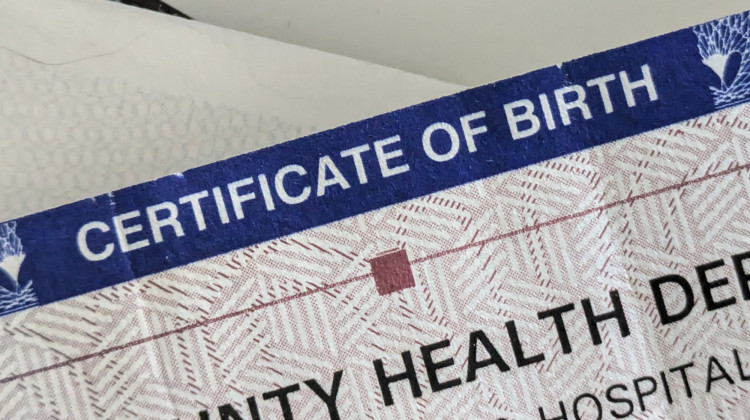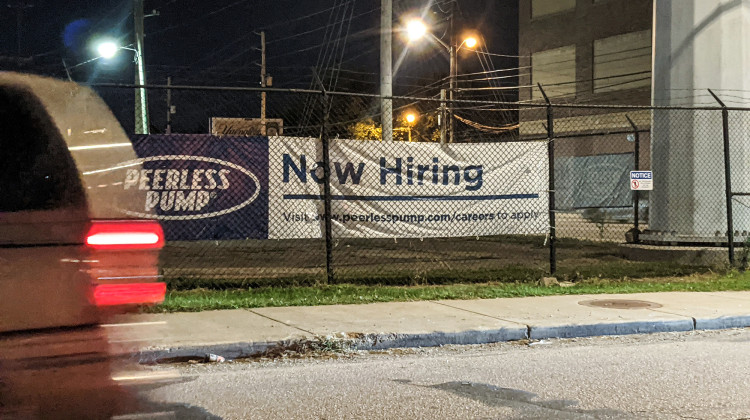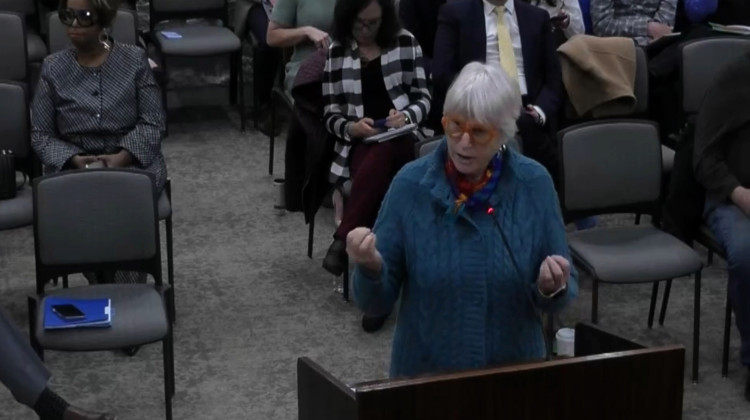
The unveiling of Barrett’s Santa statue on Dec. 23, 1935.
Photo courtesy the Indiana Archives and Records AdministrationIt’s not every day that Santa Claus winds up before a judge, but that’s exactly where the big man found himself some nine decades ago — in a case that surely goes down in Indiana Supreme Court history.
The story truly begins even farther back, circa 1854, when the southern Indiana town of Santa Fe was established. Two years later, when the Spencer County town about 40 miles east of Evansville was working to establish a post office, federal officials refused their first application, given there was already a Santa Fe, Indiana, in Miami County.
Although the details have since been lost to legend, members of the town eventually decided on a new name, Santa Claus, for which the U.S. Post Office Department gave the greenlight.
Locals still referred to the town as Santa Fe. But because the town had — and continues to have — the world’s only post office to bear the name of the famous holiday figure, the local post office started receiving thousands of letters to Santa from across the world. A group of volunteers, “Santa’s Elves,” has ensured that each child receives a reply from Santa since at least 1914.
The post office’s fame further grew in the 1920s, when the postmaster general announced that there would never be another “Santa Claus” post office in the country due to the influx of holiday mail and the staffing and logistical problems this caused.
The increasing volume of holiday mail became so substantial that it additionally caught the attention of the nationally syndicated “Ripley’s Believe it or Not!” cartoon strip in 1929. Even more letters rolled in after that.
At its peak, the office managed almost 3 million letters to Santa, according to the Indiana Archives and Records Administration.
Making money off Santa Claus
Of course, with the town’s fame came an interest from some to monetize the connection to Old Saint Nick.
That included Vincennes entrepreneur Milton Harris, who along with associate James Martin opened Santa’s Candy Castle in December 1935 — sponsored by the Curtiss Candy Company. The red-brick castle was the town’s first tourist attraction.
Another Santa Claus Town attraction followed, Santa’s Workshop and Toy Village, which featured a series of miniature fairytale-themed buildings sponsored by various national toy manufacturers.
Harris planned other expansions of Santa-related attractions and envisioned a town transformed into a Christmas village, where toys and candy would be made and given freely. Various corporations would sponsor the efforts.
As part of the scheme, he secured a lease from property owners Gearoge and Matilda Reinke for 32 acres near the Candy Castle.
But it wasn’t long before Harris’ project caught the attention of a rival entrepreneur, Carl Barrett, the Chicago president of the Illinois Automobile Club.
Disliking what he called Harris’ materialism, Barrett planned his own tourist attraction: Santa Claus Park.
Four months after Harris leased the land from the Reinkes, Barrett descended on Santa Claus to purchase the very same swath of land.
Seeking to put pressure on Harris — who had a head start on his Santa Claus attraction — Barrett also rushed to put up a massive statue of Santa Claus. He dedicated the 22-foot-tall statue of Santa Claus atop the highest hill in town on Christmas Day in 1935 — the same day Harris opened the Candy Castle.
Barrett boasted the statue was made of solid granite, and insisted, too, it was “blessed” by a fallen meteor just before the dedication.
The Chicago entrepreneur’s claims could have landed him on the naughty list, however. The statue was revealed to be concrete when cracks formed just a few years later. The nearby crater was also exposed as nothing more than a large hole filled with metal scraps.
Santa goes to court
But even before the infamous statue’s reveal, a years-long feud between Barrett and Harris had already begun.
A month earlier, Harris filed a complaint in the Spencer County Court, alleging that Barrett and his associates were not honoring the terms of the lease that Harris had signed with the Reinkes.
The Vincennes man pointed to a specific passage in the lease: “It is agreed and understood by the parties that the second party (Harris) shall have the exclusive right during the term of this lease to conduct on said real estate any and all business having any relation to the Santa Claus idea.”
Harris maintained in his complaint that he was committed to “the building of permanent and lasting improvements” in the Santa Claus village. Barrett, he argued, sought to “embarrass, hinder, damage, delay and injure” those efforts by “wrongfully erecting and threatening to build and erect various buildings, structures and signs” on the land first leased by Harris. He emphasized that Barrett was “prohibited” from developing the land without written permission.
Court documents indicate that Barrett indeed gave little credence to the lease, telling the Reinkes when he purchased the land that it “didn’t amount to anything.”
But Barrett pushed back in other filings and in the press, saying his non-profit enterprise was for the “good of children,” while Harris’ venture sought commercial gains. Harris told the court he intended for his Christmas village to eventually take a non-profit model.
After the case was transferred, a Martin Circuit Court judge Fabius Gwin disagreed with Barrett, upholding Harris’ lease and awarding the plaintiff $5,100 in damages.
Even more extreme, the county court’s ruling quieted Barrett’s title to the land, effectively giving ownership of it to Harris for at least the next 25 years.
Specifically, Gwin said in his ruling that Harris “is given the exclusive right” during the lease period “to conduct on said real estate any and all business having any relation to the Santa Claus idea, such as manufacturing and selling toys and each and every article, item or thing having any relation to, connection with, or spirit of Santa Claus in his traditional and commercial relation to Christmas time.”
Barrett’s team quickly appealed.
His legal team held that Harris’s “Santa Claus of Santa Claus, Inc.” had been incorporated after Barrett’s “Santa Claus, Inc.” and that Harris’ incorporation should not have been accepted and was invalid as it was confusingly similar.
The county judge quickly rejected the argument, noting that the Indiana Secretary of State was given the quasi-legal authority to determine when a corporate entity’s name was too similar to another and that the courts had no ability to alter that decision.
In October of 1939, the appellate court also rejected Barrett. Among other points, the ruling cited concerns with errors in the court records attributed to Barrett’s counsel. The court said “the record has been mutilated, changed, and forged” to show that a written praecipe — a type of legal filing — was filed. The clerk, however, said no such document “was ever given to him.”
Indiana’s high court weighs in
Barrett wasn’t willing to give up, though. His request to transfer to the Indiana Supreme Court was eventually granted, landing Santa Claus before the high court justices in May 1940.
The Supreme Court’s final ruling provided mixed results for Barrett. He was forced to honor Harris’s lease and would be subject to future damages if he continued to pursue the business of Santa Claus in Santa Claus.
But the judgment also produced a somewhat surprising reversal; Harris’s initial damages were significantly reduced, and the action to quiet Barrett’s title to the land was overruled.
Other costly lawsuits between the two men followed in the years to come. All the while, national news media brought additional attention to the legal battle, coined the story of “Too Many Santas.”
Included in the saga was a later case in which Barrett — who after acquiring some of his competitor’s stock — demanded either a promise of profitability or a dissolution of Harris leases. The attempt proved unsuccessful.
All the while, Barrett continued to promote his Santa Claus statue, village and other attractions, but few other aspects of the park were ever completed.
By the 1950s, both entrepreneurs’ Santa Claus projects became vacant and neglected.
Barrett did find some success when oil was discovered in the area in 1938. Harris’ leases didn’t extend rights to extract oil, but because Barrett had purchased the land outright, he was able to do so.
Although no oil mogul, Barrett went on to run the Rush Creek Oil Company in New Harmony until his retirement. He died in Evansville in 1978.
Harris struggled to secure sponsors for his attractions and only ever completed a small toy shop and workshop, in addition to the Candy Castle. After World War II, Harris lost his position as the controller of the Santa Claus business for good, this time against retired industrialist Louis J. Koch, who opened a toy factory on the outskirts of town.
In August 1946, Koch opened Santa Claus Land. Harris died soon after in Vincennes in 1950.
The park’s name was later changed to Holiday World in 1984. It’s still owned and operated by the Koch family, attracting more than 1 million visitors annually.
Koch secured another pivotal win when he discovered that the town had never officially changed its name. The realization meant he could organize his unincorporated area as the first — official — Santa Claus, Indiana.
 DONATE
DONATE






 Support WFYI. We can't do it without you.
Support WFYI. We can't do it without you.